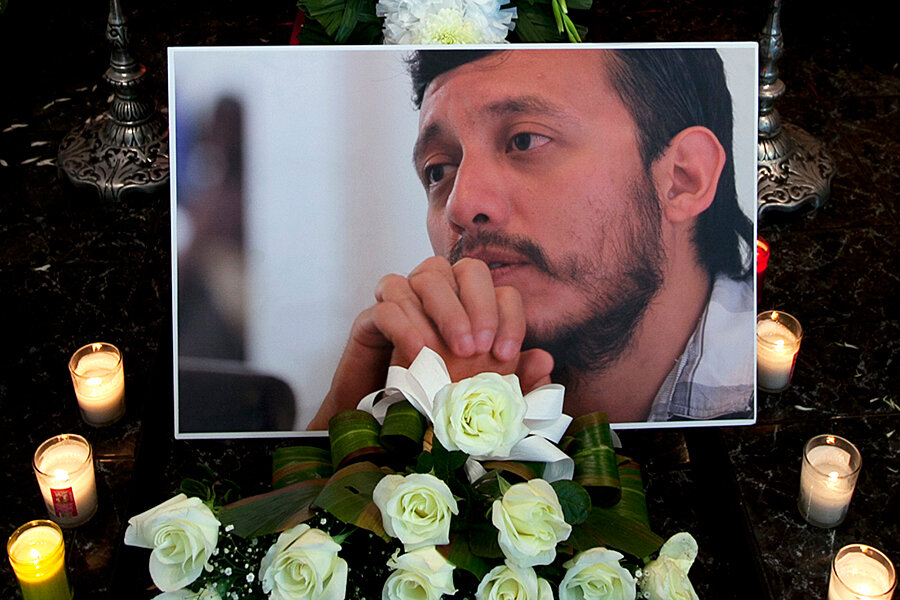Mexico City: Why didn't slain journalist Ruben Espinosa seek protection?
Loading...
| Mexico City
Under threat, Mexican photojournalist Rubén Espinosa fled the state of Veracruz, where he worked. His murder last week underscores not only the dangers journalists face in Mexico, but how little faith reporters here have in promises of government protection.
Mr. Espinosa, who worked for respected news outlets like the investigative magazine Proceso, fled in June after being harassed and telling others his home was under surveillance. He relocated to Mexico City, considered safe by many reporters and human rights defenders threatened in Mexico.
On Friday, Espinosa and four women – one a social activist – were found dead in an apartment in a middle class neighborhood. Their bodies showed signs of torture.
Mexico is one of the most dangerous countries for journalists. More than 50 have been murdered or disappeared since 2011, according to the Committee to Protect Journalists. And it ranks 148th out of 180 countries in the most recent World Press Freedom Index, below nations like Venezuela and Myanmar.
In 2012, Mexico created a program within the ministry of the interior to provide protection for journalists and human rights defenders under threat. But continuing violence, impunity, and a widespread belief that government officials are linked to criminal groups have made some reporters reluctant to initiate the protection measures.
“There’s a lack of confidence in what the government can do,” says Michael W. Chamberlin, a human rights expert at the Friar Juan de Larios Human Rights Center who was appointed to the civil council for the government’s protection program when it launched in 2012. He confirmed Espinosa did not request support from the government’s program at the state or federal level.
“There’s not only the fear that the mechanism [granting protection to journalists] won’t work, but there’s also the fear that it will make things worse for the person facing threats,” Mr. Chamberlin says.
The government “at the highest levels” must take a stand, says Carlos Lauría, the Americas program coordinator for The Committee to Protect Journalists.
The protection program is “characterized by ineffectiveness,” says Mr. Lauría, citing examples of journalists given “panic buttons” that malfunctioned in emergencies, or who lost their protection without a clear explanation of why that happened.
“The level of impunity is so high, the collusion between authorities and criminals, particularly at the state level is also so high, that it leaves journalists without options,” Lauría says.
'Not one more'
On Sunday several hundred protesters gathered in Mexico City to draw attention to Espinosa’s death and protest the government’s frail response. They held cameras in honor of the slain photographer and carried signs that read: “not one more,” and “he was assassinated.”
Mexico City prosecutor Rodolfo Rios Garza said Sunday that all lines of investigation were being pursued. Yet he didn’t acknowledge that Espinosa had fled Veracruz for his safety, which worries free-press advocates who fear the role of journalism in Espinosa’s death could be downplayed.
Espinosa didn’t reach out to the government for help because, he “had more confidence in civil agencies ... and his friends,” Dario Ramirez, the director of the free press advocacy group Article 19, told the Associated Press.
This stance raises questions about whether Mexico's protection program should have stepped in to offer unsolicited support, says Chamberlin.
“It’s something we are asking ourselves. What happens when the reporter doesn’t call the mechanism but the mechanism knows he is at risk? How far should it go?”
A report published earlier this year by the Washington Office on Latin America (WOLA) and Peace Brigades International highlights the challenges for protection, included understaffing, poor training, and the need for more robust risk analysis.
Veracruz a special problem
“On the one hand you’ve got bureaucracy within the mechanism itself,” says Clay Boggs, a program officer at WOLA who helped write the report. “On the other side, there’s the failure of the state and local governments to provide the measures they’re supposed to,” he says.
Veracruz, where Espinosa worked, has a particularly poor track record for journalist safety. Some 11 journalists have been killed since 2010, while another three have gone missing.
In June, Veracruz Gov. Javier Duarte sent a chilling message to journalists, telling them to “behave themselves,” and implied an ongoing collaboration between reporters and criminal groups.
"We must not confuse freedom of expression with representing the expression of criminals in the media," he said.
As of July, Mexico's protection program has received 203 cases, including 279 people seeking government assistance.
Some 114 of those individuals were journalists, according to Espacio de Organizaciones de la Sociedad Civil, an umbrella group made up of 20 NGOs that work to protect human rights defenders and journalists.
“The insecurity of journalism is the insecurity of everyone,” writes Jesús Silva-Herzog Márquez in an opinion for leading daily Reforma today. “When [journalists] don’t have the conditions to do their work, all of society gets attacked.
“The fear felt by a reporter to do his or her job is ours,” the article went on. “They want to silence them so that we are all deaf. They want to hide the truth so that we are all blind. They want to silence them so that we become silent.”








